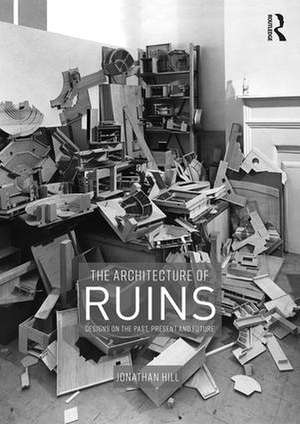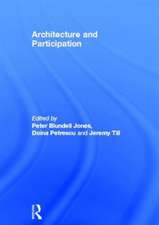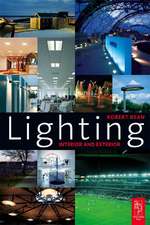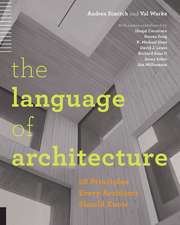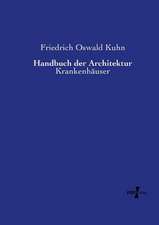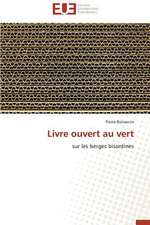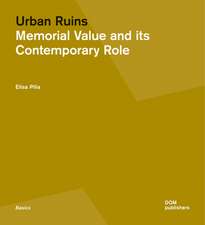The Architecture of Ruins: Designs on the Past, Present and Future
Autor Jonathan Hillen Limba Engleză Hardback – 9 apr 2019
Structured around a collection of biographies, this book conceives a monument and a ruin as metaphors for a life and means to negotiate between a self and a society. Emphasising the interconnections between designers and the particular ways in which later architects learned from earlier ones, the chapters investigate an evolving, interdisciplinary design practice to show the relevance of historical understanding to design. Like a history, a design is a reinterpretation of the past that is meaningful to the present. Equally, a design is equivalent to a fiction, convincing users to suspend disbelief. We expect a history or a novel to be written in words, but they can also be delineated in drawing, cast in concrete or seeded in soil. The architect is a ‘physical novelist’ as well as a ‘physical historian’.
Like building sites, ruins are full of potential. In revealing not only what is lost, but also what is incomplete, a ruin suggests the future as well as the past. As a stimulus to the imagination, a ruin’s incomplete and broken forms expand architecture’s allegorical and metaphorical capacity, indicating that a building can remain unfinished, literally and in the imagination, focusing attention on the creativity of users as well as architects. Emphasising the symbiotic relations between nature and culture, a building designed, occupied and imagined as a ruin acknowledges the coproduction of multiple authors, whether human, non-human or atmospheric, and is an appropriate model for architecture in an era of increasing climate change.
| Toate formatele și edițiile | Preț | Express |
|---|---|---|
| Paperback (1) | 314.86 lei 3-5 săpt. | +35.23 lei 4-10 zile |
| Taylor & Francis – 24 apr 2019 | 314.86 lei 3-5 săpt. | +35.23 lei 4-10 zile |
| Hardback (1) | 1000.27 lei 6-8 săpt. | |
| Taylor & Francis – 9 apr 2019 | 1000.27 lei 6-8 săpt. |
Preț: 1000.27 lei
Preț vechi: 1219.84 lei
-18% Nou
Puncte Express: 1500
Preț estimativ în valută:
191.46€ • 208.04$ • 160.93£
191.46€ • 208.04$ • 160.93£
Carte tipărită la comandă
Livrare economică 21 aprilie-05 mai
Preluare comenzi: 021 569.72.76
Specificații
ISBN-13: 9781138367777
ISBN-10: 113836777X
Pagini: 374
Ilustrații: 105
Dimensiuni: 174 x 246 mm
Greutate: 0.45 kg
Ediția:1
Editura: Taylor & Francis
Colecția Routledge
Locul publicării:Oxford, United Kingdom
ISBN-10: 113836777X
Pagini: 374
Ilustrații: 105
Dimensiuni: 174 x 246 mm
Greutate: 0.45 kg
Ediția:1
Editura: Taylor & Francis
Colecția Routledge
Locul publicării:Oxford, United Kingdom
Public țintă
Postgraduate, Professional, and UndergraduateCuprins
List of Figures
Acknowledgements
Introduction
Chapter 1 Monuments to Rome
Chapter 2 The First ‘Ruins’
Chapter 3 Architecture in Ruins
Chapter 4 Speaking Ruins
Chapter 5 Ruin and Rotunda
Chapter 6 Life in Ruins
Chapter 7 Wrapping Ruins Around Buildings
Chapter 8 Nations in Ruins
Conclusion A Monument to a Ruin
Bibliography
Acknowledgements
Introduction
Chapter 1 Monuments to Rome
Chapter 2 The First ‘Ruins’
Chapter 3 Architecture in Ruins
Chapter 4 Speaking Ruins
Chapter 5 Ruin and Rotunda
Chapter 6 Life in Ruins
Chapter 7 Wrapping Ruins Around Buildings
Chapter 8 Nations in Ruins
Conclusion A Monument to a Ruin
Bibliography
Notă biografică
Jonathan Hill is Professor of Architecture and Visual Theory at the Bartlett School of Architecture, University College London, where he directs the MPhil/PhD Architectural Design programme. He is the author of The Illegal Architect (1998), Actions of Architecture (2003), Immaterial Architecture (2006), Weather Architecture (2012) and A Landscape of Architecture, History and Fiction (2016); editor of Occupying Architecture (1998) and Architecture—the Subject is Matter (2001); and co-editor of Critical Architecture (2007).
Descriere
The Architecture of Ruins: Designs on the Past, Present and Future identifies an alternative and significant history of architecture, from the sixteenth century to the twenty-first, in which a building is designed, occupied and imagined as a ruin.
